Pete Townshend had a busy and exciting time in New York City this week! He came to town to promote and attend performances of the revival of The Who's Tommy on Broadway. The new production officially opened at the Nederlander Theatre on March 28, after a successful run of previews that began March 8.
On Tuesday, a couple days before the opening, Pete appeared on the Tonight Show where he had a nice chat with his friend Jimmy Fallon before joining Ali Bourzgui and the cast of Tommy to perform a wonderful medley of Pinball Wizard, See Me Feel Me, and Listening to You. They all did a fantastic job, and it was an excellent preview of the show!
The following night Pete went to the final preview performance of Tommy, where he attended a special pre-show gathering of alumni from the original 1993 Broadway production of The Who’s Tommy. After the show Pete graciously posed for group photos with the past and current casts, who got to meet and mingle together.
On Thursday, Pete attended the opening night show of Tommy, which was an invitation only special event for press and friends. At the end of the show, Pete joined Des McAnuff and the cast after the stage bow.
Pete told the audience, “It's so wonderful to be here on this opening night. I hope you have... well you have enjoyed it. And dare I say it, this is strange for me because I am very blasé about this business. I've been in it since I was 4 years old. I wasn't a performer but my father was a musician in a band, and I grew up backstage, and I'm very comfortable here. I'm so comfortable that I occasionally get blasé. And tonight my dreams and hopes of being back on Broadway have been blown into the sky, and here we are back again. It's so great to be here and thank you for supporting us the way you have tonight.”
Earlier in the month, Pete attended the first night of Tommy previews on March 8, and spent a few days in New York doing press work to promote the production. He sat for an extensive interview with the New York Times, which was featured in a full page spread in the Arts & Leisure section on Sunday, March 24. Pete also filmed an interview with CBS Sunday Morning, which is slated to air on March 31.
Congratulation to Pete Townshend, Des McAnuff, and the cast and crew of The Who's Tommy for the successful launch of a production that will hopefully have a long run on Broadway!
Many thanks to everyone who contributed reviews and photos from the shows!
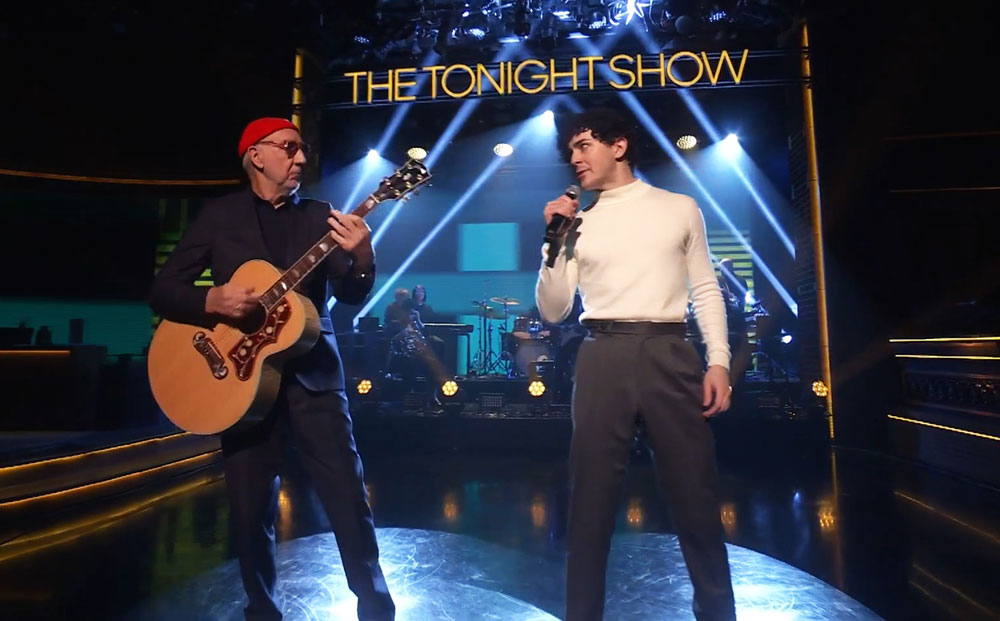 Screenshot from Pete's appearance on The Tonight Show
Screenshot from Pete's appearance on The Tonight Show
Interview with Pete Townshend on the Tonight Show.
Interview with Pete Townshend and feature about Tommy musical on CBS Sunday Morning.
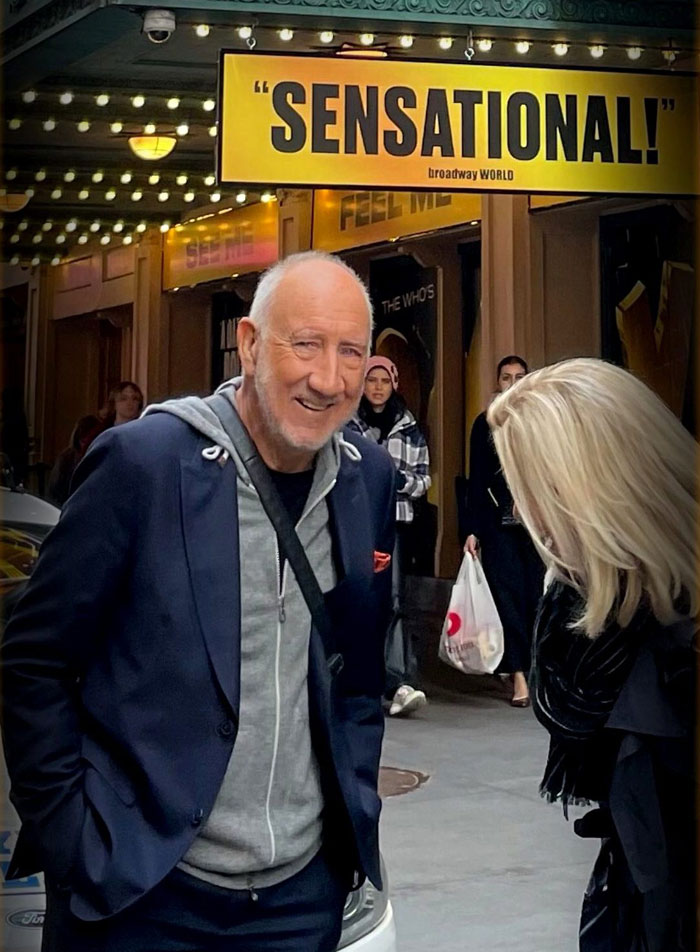 Pete Townshend in front of the Nederlander Theatre at the first preview performance on March 8. Photo credit: The Who's Tommy Musical Facebook page.
Pete Townshend in front of the Nederlander Theatre at the first preview performance on March 8. Photo credit: The Who's Tommy Musical Facebook page.
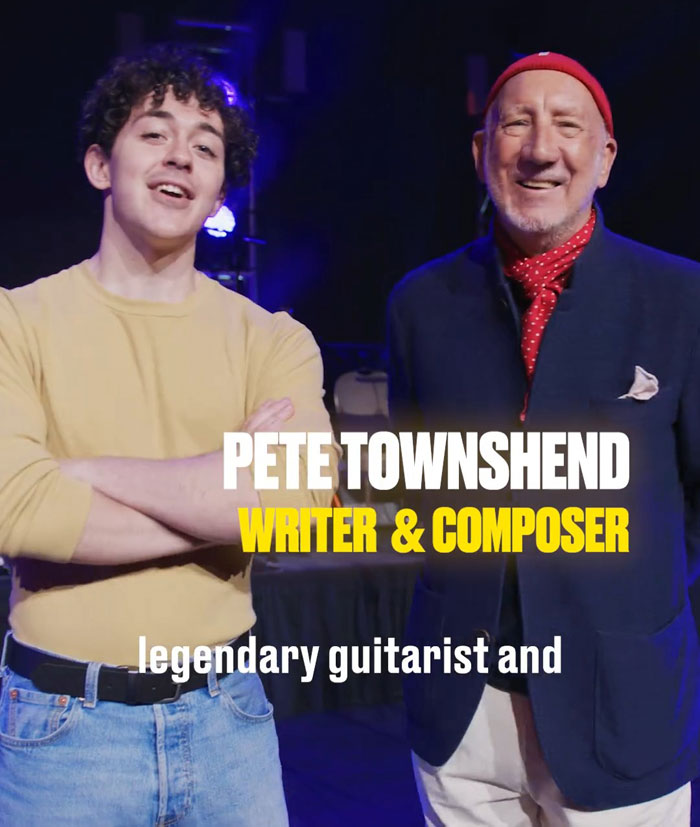 Screenshot of Pete and Ali Bourzgui in The Who's Tommy Musical promotional video.
Screenshot of Pete and Ali Bourzgui in The Who's Tommy Musical promotional video.
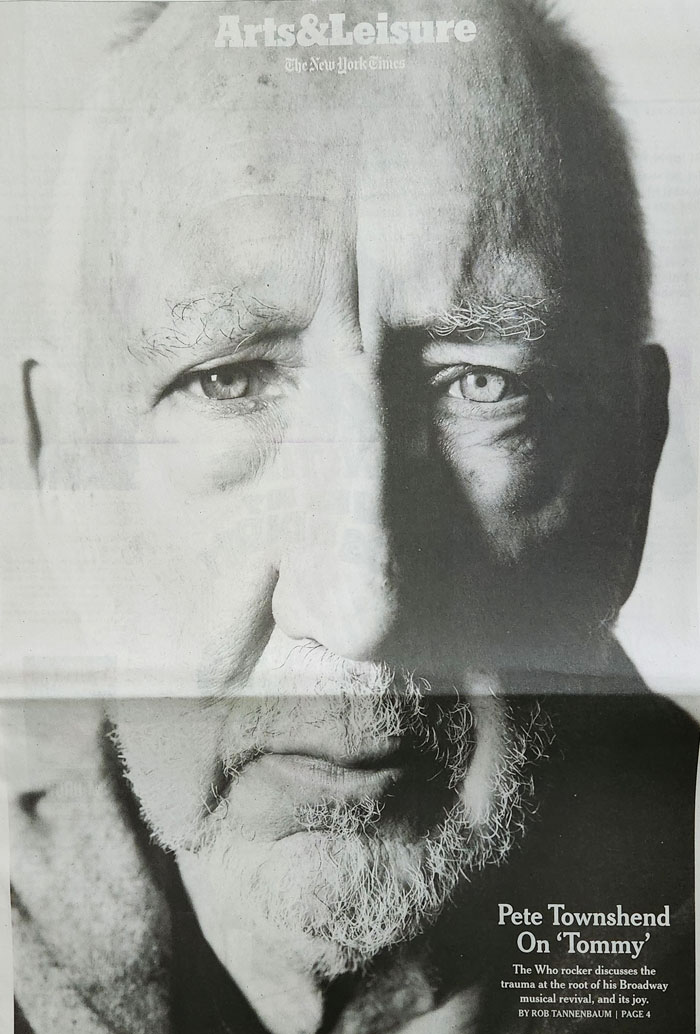 Full page spread for Pete's interview in New York Times.
Full page spread for Pete's interview in New York Times.
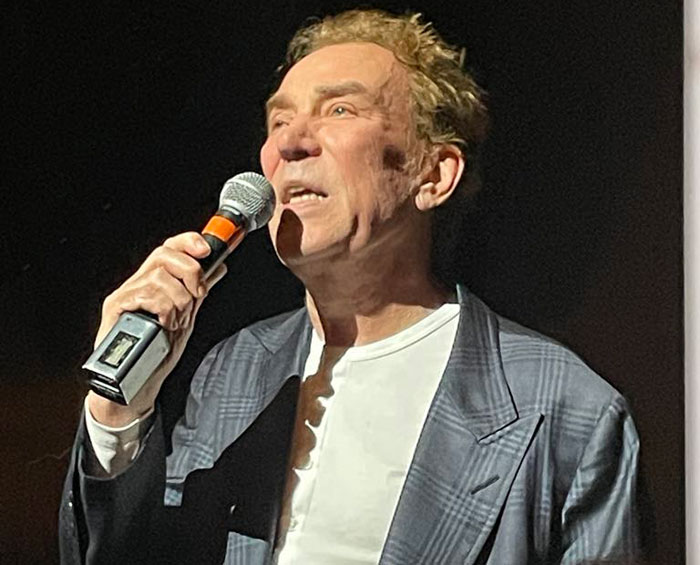 Des McAnuff addresses audience before the final preview show on March 27. Photo credit: Stuart Haber.
Des McAnuff addresses audience before the final preview show on March 27. Photo credit: Stuart Haber.
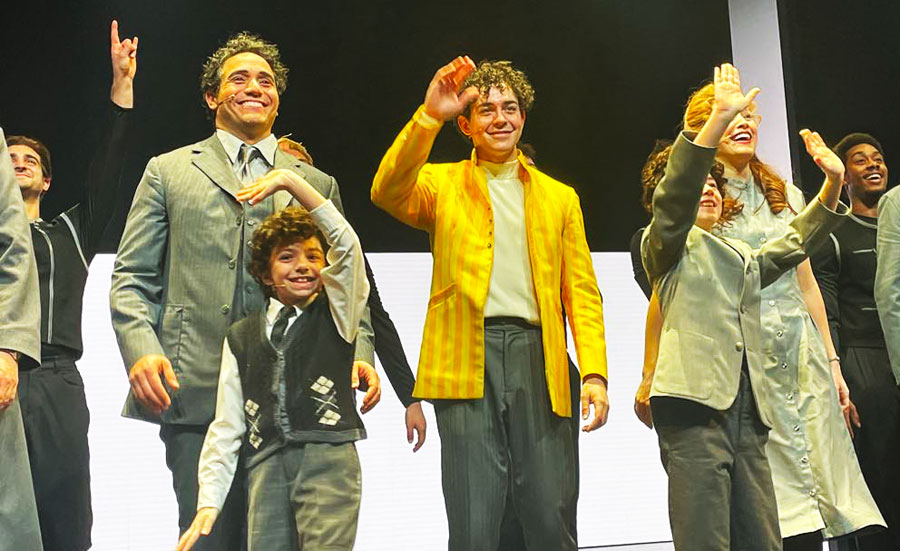 Stage bow on final night of preview performances. Photo credit: Stuart Haber.
Stage bow on final night of preview performances. Photo credit: Stuart Haber.
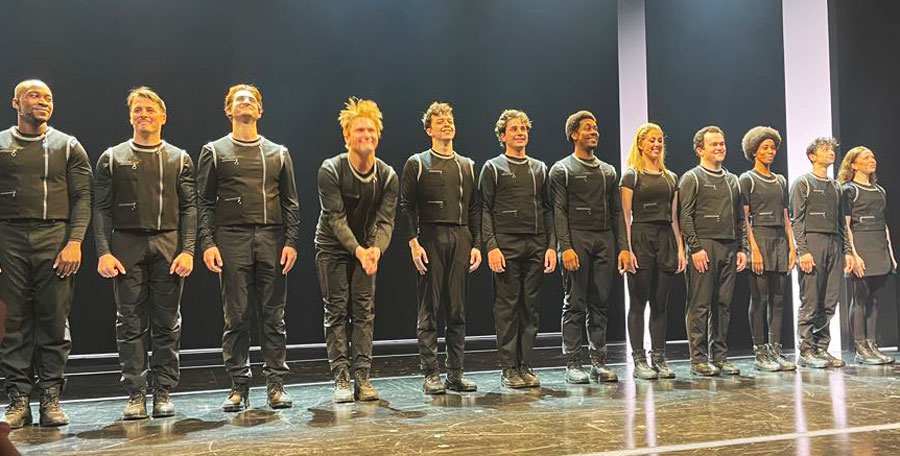 Stage bow on final night of preview performances. Photo credit: Stuart Haber.
Stage bow on final night of preview performances. Photo credit: Stuart Haber.
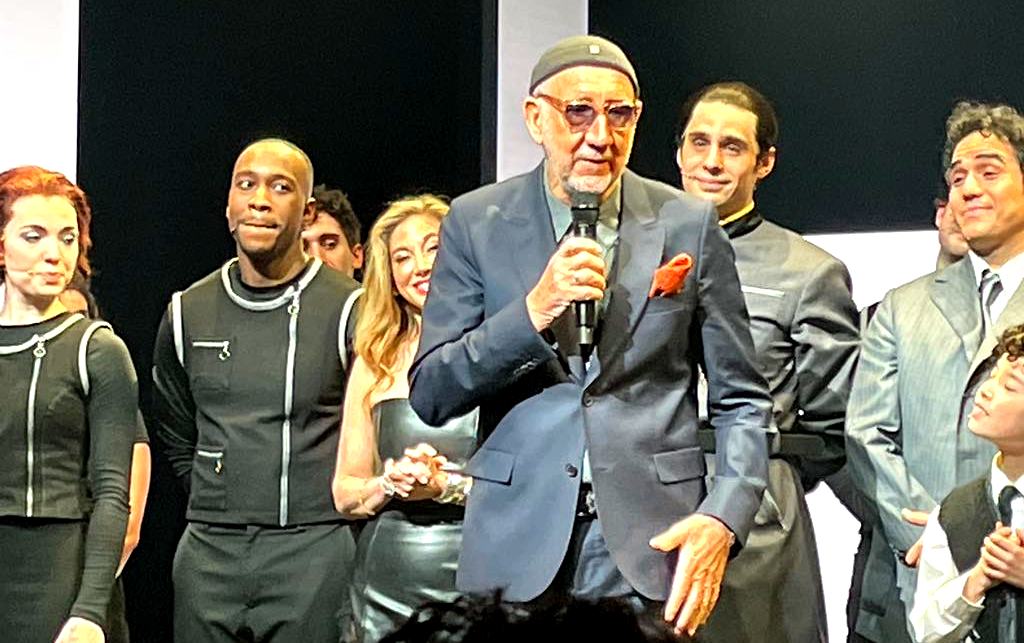 Pete joins cast of Tommy on opening night. Photo credit: Stuart Haber.
Pete joins cast of Tommy on opening night. Photo credit: Stuart Haber.
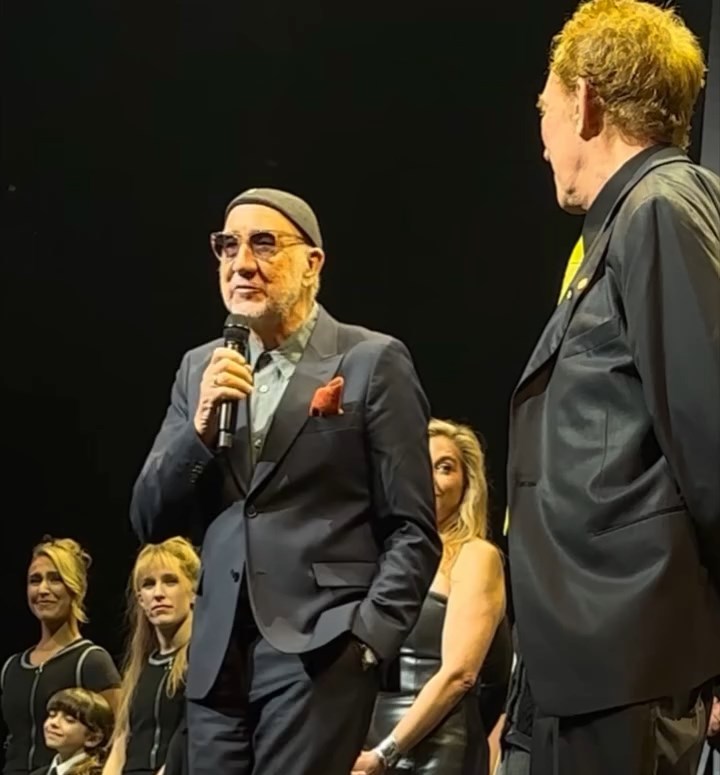 Pete joins Des McAnuff and cast of Tommy on opening night. Screenshot of Broadway.com video.
Pete joins Des McAnuff and cast of Tommy on opening night. Screenshot of Broadway.com video.
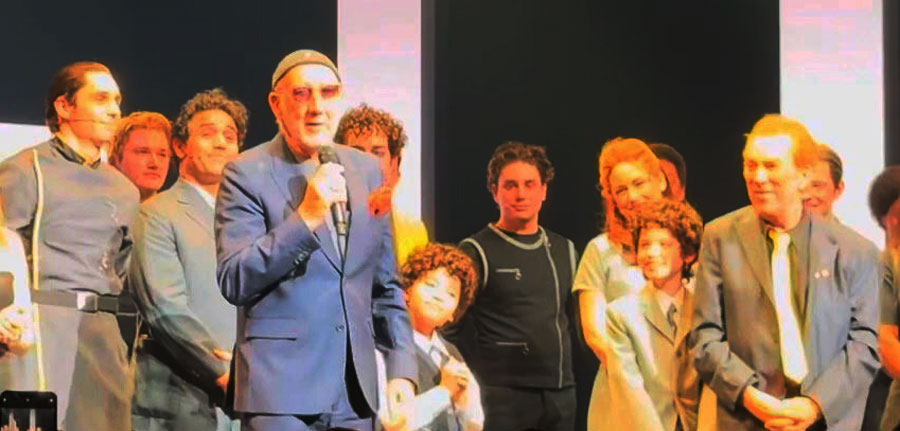 Pete joins Des McAnuff and cast of Tommy on opening night. Screenshot of youtube video.
Pete joins Des McAnuff and cast of Tommy on opening night. Screenshot of youtube video.
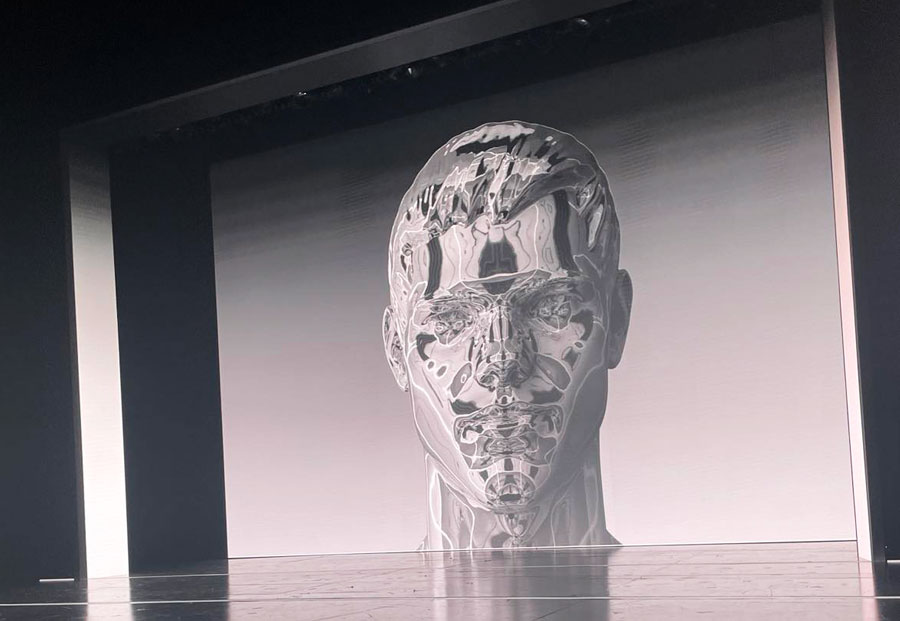 Image projected on stage screen before Tommy. Photo credit: Stuart Haber.
Image projected on stage screen before Tommy. Photo credit: Stuart Haber.
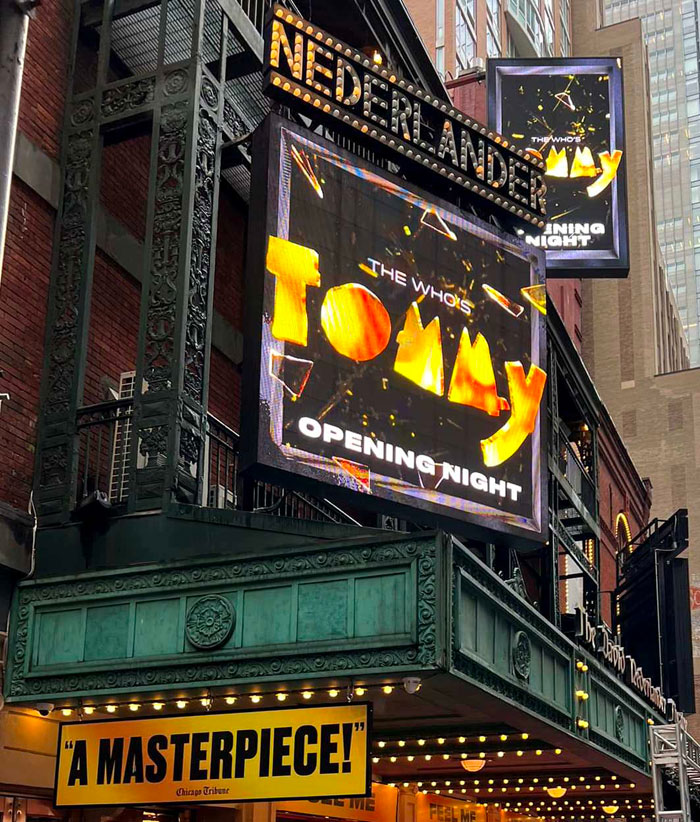 Nederlander Theatre on opening night.
Nederlander Theatre on opening night.
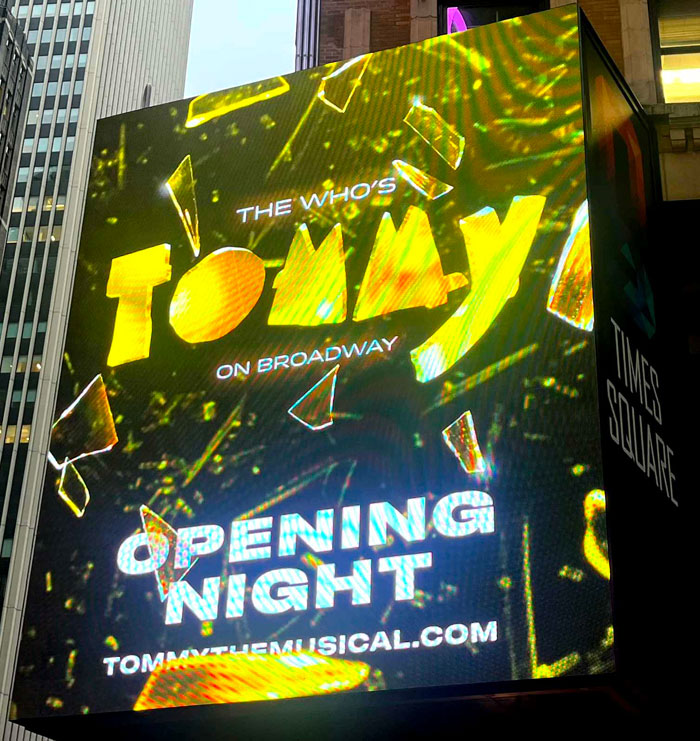 Tommy up in bright lights in Times Square on opening night.
Tommy up in bright lights in Times Square on opening night.
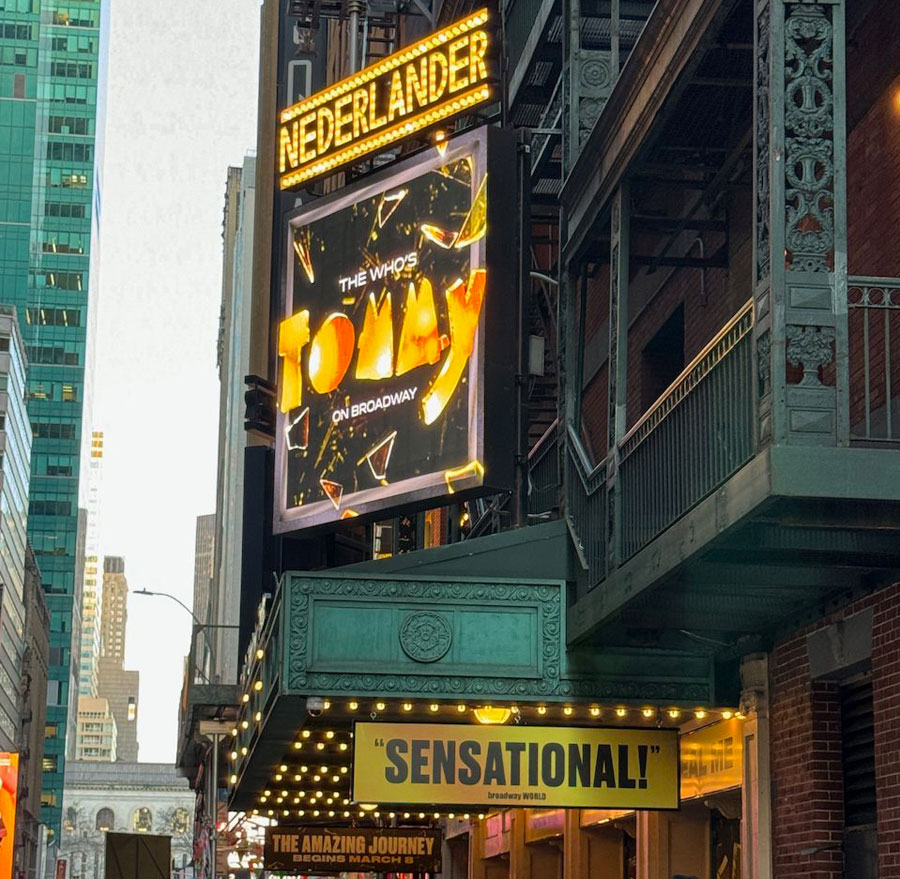 Nederlander Theatre. Photo credit: Alan McKendree.
Nederlander Theatre. Photo credit: Alan McKendree.
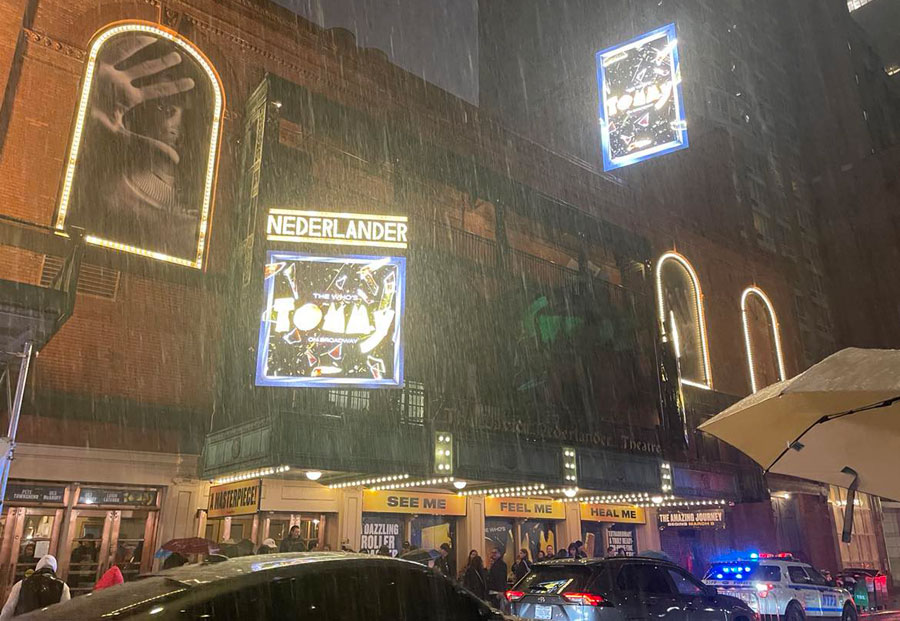 Nederlander Theatre in the rain. Photo credit: Stuart Haber.
Nederlander Theatre in the rain. Photo credit: Stuart Haber.
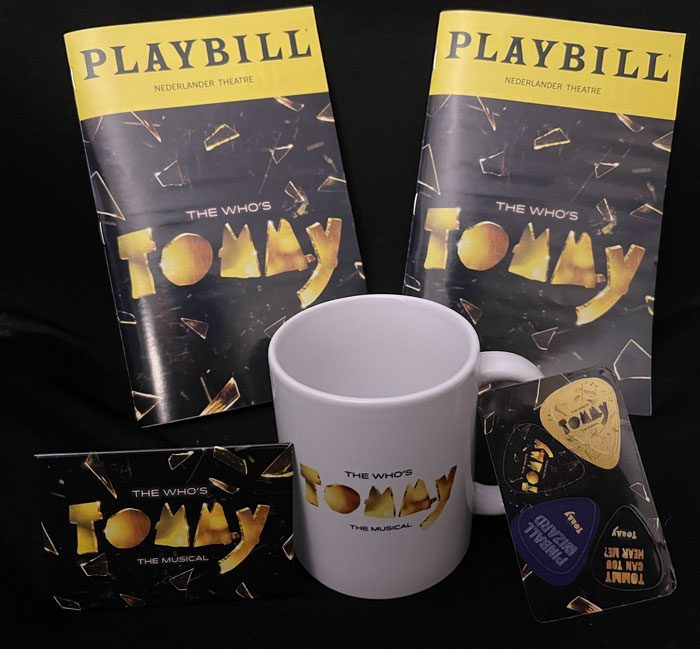 Tommy merchandise. Photo credit: Mike Kosturko.
Tommy merchandise. Photo credit: Mike Kosturko.
Review of March 27 performance by Gigi Barlowe
Last night I attended the final preview of the revival of Tommy on Broadway. I must admit that I never saw the original version in 93’. I was going through a rough patch back then and in my childish mind, no one else could be Tommy, but Roger Daltrey. That said, I came to this production with a clean slate. I am much more affiliated with the Broadway community today, because our daughter has been on Broadway twice. We have a friend in this new production.
It was a stunning, captivating evening. It was the final preview and it was dedicated to Alumni from 93’. The pre show party was filled with many alums, including Donny Kehr (Rockers on Broadway), and Broadway veteran Norm Lewis, who actually made his debut in Tommy in 93’. We met Des McAnuff, the director who talked to my daughter quite a bit and said he hoped he would get to work with her some day, so sweet of him. I got to see people I have not seen in awhile, including Bill Curbishley, who was very chatty. Pete worked the room and made sure he greeted everyone.
Back to the show. For Who fans and purists, you need to know that this is a Broadway show! The staging is spectacular as well as the lighting and effects. It made for a very powerful presence, even though the stage itself is fairly bare. Pinball machines are empty squares that come alive with light and sound. It’s really brilliant. The performances are broadway excellence and the casting is quite good. If you are looking for Ann Margaret and Oliver Reed, you better look again. The story line is also slightly different but the play mostly sticks to the original story. The Tommy lead is also fantastic, but the only resemblance to RD are his curls, he’s a brunette. He handles the role with his own spin.
After the show, the 93’ cast got to meet with the present cast and with Pete center stage, many smiles and photos. It was very special.
Without going into more details, I would absolutely recommend everyone see this show if you can get to NYC. I’m sure it will tour eventually. I will close by saying, that as a Who fan first, the best part about the show is still Pete Townshend’s music. It fills a theater and fills your heart. I loved seeing Pete during the curtain calls and bows. He was like a proud papa. (With Sting and Trudi, a few rows behind him.)
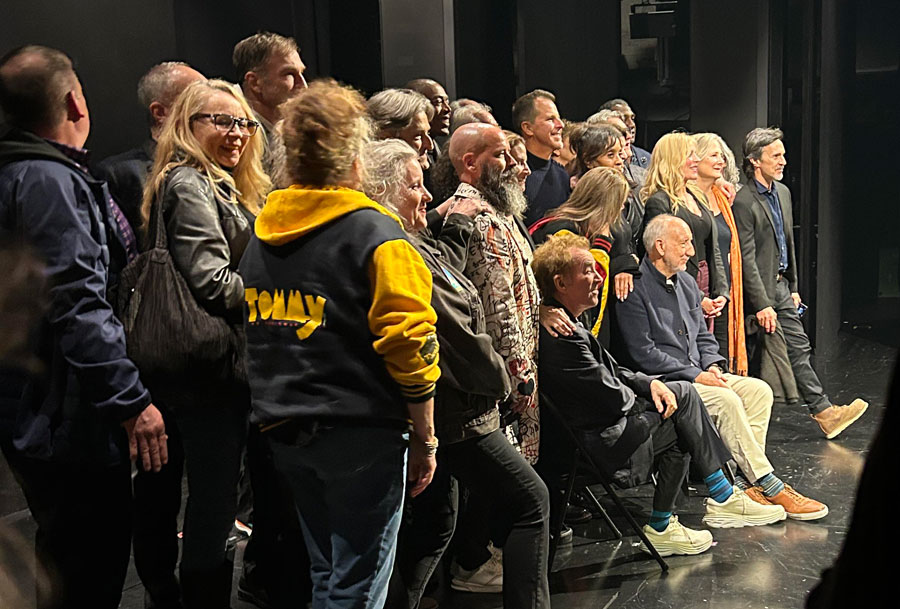 Pete posed for a group shot of '93 Broadway alumni and present cast after final preview show. Photo credit: Gigi Barlowe.
Pete posed for a group shot of '93 Broadway alumni and present cast after final preview show. Photo credit: Gigi Barlowe.
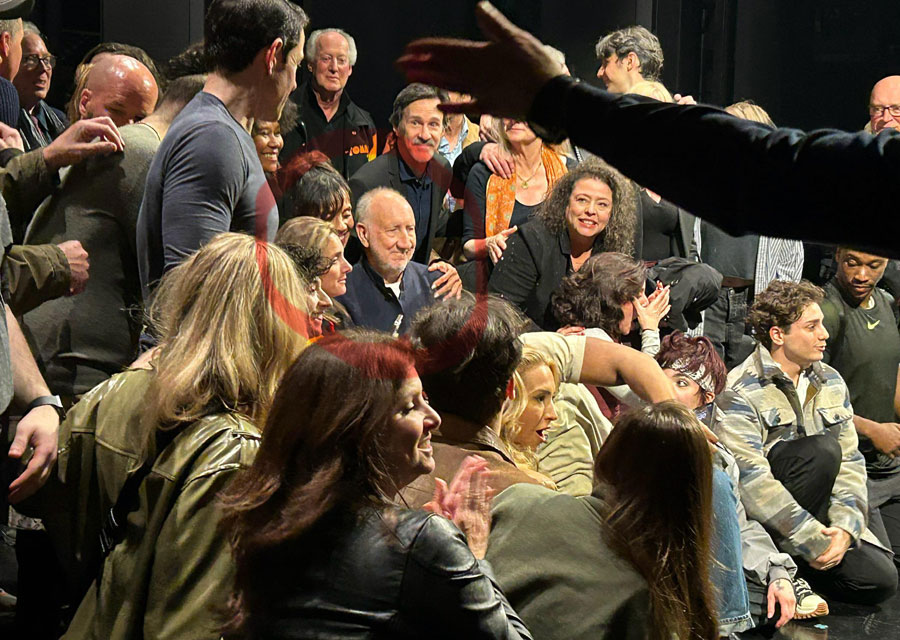 Pete posed for a group shot of '93 Broadway alumni and present cast after final preview show. Photo credit: Gigi Barlowe.
Pete posed for a group shot of '93 Broadway alumni and present cast after final preview show. Photo credit: Gigi Barlowe.
Review of March 27th and opening night March 28th by Stuart Haber
I had the honor and privilege of seeing Tommy the musical this past week including opening night when Pete Townshend was present and Des McAnuff introduced both performances.
The show is wonderful. The music of course is supreme. The use of costuming and scrims for projections was brilliant and emotive. You start with the backdrop of World War 2 and soldiers and the meeting of the Walkers followed by their marriage and then Captain Walker is presumed dead. Mrs Walker eventually finds a new lover, Tommy is born and then the tragedy/trauma……
The concept of childhood PTSD is so aptly appropriate to this scene and the greater recognition we have now than in decades past. And it hits you when young Tommy first looks in the mirror.
And the swirl of dancers and song just carry you on the journey.
Uncle Ernie was carefully and skillfully portrayed both matter of fact and soberly. No humor nor apathy to the concept of childhood sexual abuse is shown here and Uncle Ernie is seen as a very sad and pathetic man.
The costumes were great and the changes frequent: their costumer/dressers were very busy backstage!!
Alison Luff and Adam Jacobs are great as Mr and Mrs Walker.
And then there is Tommy, played by Ali Bourzgui who was in the Chicago production. He was ernest and in great singing form throughout the show.
The cousin Kevin scene was done really well and then later when his comrades and other bullies in their dance routine join, it harkens back to some of the dancing I saw in West Side Story.
And the most touching part of this show, where this abused kid is in front of the pinball machine, he matter of factly plays it so well and all the rough teens gradually look over at this marvel of a kid.
The Acid Queen is a homage to Tina Turner and Christina Sajous does it so fiercely.
The first act closes with Pinball Wizard and it is powerful.
The second act deals of course with finding a cure, getting him for medical tests and exams and finally ,….smashing the mirror.
The crumpled newspapers showing Miracle Cure on the stage skillfully reflect old England.
Sally Simpson follows and is really fun and then serious and dramatic.
Listening to You at the end builds a crescendo with sound and eventually all of the actors joining the Walkers. The audience both nights rose to their feet with this before the actual curtain call!
This was all in all an excellent production and I have plans to see it multiple times.
I also want to address some of the criticisms listed in the New York Times as the review made it online opening night and we read it at the Tommy after-party. Jesse Green found the production to be sensory overloaded and lacking a sense of humanity. I cannot respond to his criticism of the lack of use of strings in the orchestra as I do not remember that from 30 years ago when I saw Tommy on Broadway last. But I disagree totally that there is a lack of humanity in this production. There is enough violence and abuse portrayed and it generates a tenderness and empathy for both Tommy and his parents that is heartfelt. The show is sensory intense but IMHO not overloaded. As for two hour 15 minute production being too swift vs 3 hours long, well as a New Yorker with a touch of ADD, I prefer shorter Broadway performances and find three hours generally too long.
There was also criticism of the lyrics and the plot points not making sense or being contradictory. Tommy was not originally written by Pete Townshend for the Broadway stage and rock songs can be full of weird references and nonsensical lyrics. The best approach is to experience rock songs as how they feel rather than nitpicking the lyrics. Maybe a Who superfan should not write a fair/balanced New York Times review of Tommy, but I sense a relative baseline indifference to Tommy from Jesse Green.
And after the opening night show, we went to the afterparty at The Ziegfeld ballroom. The Ziegfeld was a famous theater opened in 1927 then torn down and then rebuilt as a large one screen movie theater in 1969. Tommy the movie premiered there in 1975 and yes I saw it there!
Anyway the ballroom is a really classy place. The actors, producers, various Broadway people were there. There were images of the current Tommy icon inside and outside the theater. Most of the attendees were dressed to the nines, but a few of us wore Who gear. :) There were standing tables and sit-down reserved tables. In the far corner in front of the stage somewhat cordoned off sat Pete and Rachel. Although I did not have an opportunity to sit down with Pete, I was able to congratulate him later and shake his hand! All in all an amazing experience or perhaps say amazing journey!
Review of March 12/14 performances by Alan McKendree **contains spoilers!**
On entering the Nederlander Theatre, the audience is greeted by a proscenium edged on three sides with wide fluorescent white bars. The curtain (front scrim) is a grey featureless sheet, but soon one notices occasional video artifacts streaking by. The overall effect is that of a single giant flatscreen TV or computer screen. Spacey whooshes and rumbles play in the background, evoking airplanes and war or, alternatively, psychic or mental travels.
The lights go down and as the audience applauds a projection appears on the translucent front scrim:
IN THE FUTURE
Projected vertical and horizontal thin white lines appear, forming a widely-spaced grid against the black fabric while black-clad human figures appear onstage in the background. One enters elevated above the rest; he(?) silently raises a helmet high, and leads the others in doing the same and donning the helmets. These helmets, with black reflective face shields—“gridhelmets” or “gridmasks”—will be seen later.
Who fans at this point might think that they’re watching a stage reference to experience suits.
Silence. Tableau.
And then the opening chord strikes, and we’re off. The scrim rises; a projection gives us
1940
at the rear, and we’re in the heat of WW II, as Tommy’s parents meet and marry, and his father goes to war, is wounded and captured. An interesting note: a projection shows
mannschaftsstammlager
in letters 6 feet high and spanning the length of the stage, with Captain Walker visible behind it; this turns out to be an actual camp where enlisted prisoners of war were kept. As such, it appears to be an historical error, as a Captain wouldn’t have gone to a camp for enlisted men.
Throughout the play, the visual concept is largely a white, black and silver palette, which creates a gloomy, foreboding air and recalls the initial picture we saw of the future. It’s relieved by a sparing use of color, including Tommy’s signature yellow that appears in key objects—for example, a bouquet of flowers that young Tommy presents to his mother, a bright yellow balloon he receives at the doctor’s, etc. The other key visual is a grid; movable vertical and horizontal lighted rods combine with projections and lighted onstage frames to create constant reconfigurations of right angles and rectangles.
As we know, Captain Walker returns from the war and shoots the Lover in Tommy’s presence. In the ensuing chaos, there’s a remarkably effective moment when Uncle Ernie snaps a flash photo of Tommy. With the flashbulb, there’s a sharp high “crack,” like a glass rod breaking, and the background projections of the house exterior snap to negative, symbolizing Tommy’s mind “breaking.”
In “Christmas” the celebration is held at the relatives’ house and we first see Cousin Kevin; later we’ll see in his jacket his signature color orange, which is related to yellow—i.e. yellow with red (anger, violence) added.
It’s noteworthy that while “Eyesight to the Blind” (featuring the powerful Danny Quadrino on harmonica and harmony vocals) and “Acid Queen” are effectively and menacingly performed, here “Eyesight” is about the Acid Queen, and Tommy’s father changes his mind at the last moment in the latter song—even though he’s already paid the Acid Queen for her services, he rushes to Tommy and snatches him away as he (Tommy) approaches her. That makes the Acid Queen more of a focus than she was in the album, and thus two songs that were originally about two different events that Tommy experienced end up having little actual effect on him in his journey.
“Pinball Wizard” closes Act I, ending with a wall-to-wall, top-to-bottom blaze of yellow and orange, aided by various perspective lines with Tommy as the focus, ringing down the curtain to allow the audience its time to applaud and reflect.
Projection:
1960
The second act opens with a punchy, short “Underture,” followed quickly by “There’s a Doctor” and “Go to the Mirror.”
In the original album, going to the mirror was a suggestion by the Specialist for a new treatment; a mirror is never mentioned until that song. That’s the breakthrough for which a Specialist was needed; he couldn't cure Tommy directly, but he did have the intuition and training to suggest Tommy go to a mirror, which was eventually an essential part of his cure. As such, that song represents the climax of the work. After “Go to the Mirror,” we know things will work out, although we may not know how.
In the album, one can infer any amount of time passing between the doctor’s recommendation, Mrs. Walker’s “Tommy, Can You Hear Me?” and her ultimate frustration in “Smash the Mirror.” The fact that the latter songs are both sung by Mrs. Walker makes her emotional transition from concern to anger believable.
By contrast, the mirror was introduced far earlier in the movie (which is why the lyrics “Go to the mirror” are eliminated from the song in the movie). It’s a difficult problem to solve in a stage production; on stage, it would be hard (although perhaps not insoluble) to introduce a mirror for the first time during the doctor’s song, and then a mere 7-8 minutes later have Mrs. Walker become so frustrated that she smashes it. If she sang “Tommy, Can You Hear Me?” it would help, but that’s given to the local kids as a mocking taunt, and “I Believe My Own Eyes,” as well as developing the parents’ relationship, serves as a spacer before “Smash.”
All this goes to drain some of the power from “Go to the Mirror.” Tommy’s been staring at the mirror in full view of the audience for much of the show at that point, so the Specialist’s recommendation seems to amount to resignation, not a breakthrough. Nevertheless, I’d like to see “Go to the Mirror” given all the power that can be mustered, if only because it introduces the “Listening to You” theme.
The Specialist (Sheldon Henry) who sings “Go to the Mirror” is accompanied by a line of silent assistants, and they all pretend to scan medical reports between lines of the song. While Mr. Henry’s voice is accurate, and adequate, I would have liked to have heard more power and emotional involvement. I’m curious how the song would fare with an operatically trained singer—not to give it the full operatic treatment, but to have more power at work. We need to know this song is the turning point in Tommy’s problem.
After two viewings, I still need to verify whether a back projection of Meher Baba appears during “Listening to You,” which the three Tommys sing. If so, it’s of him as a young man (dark hair) and an extreme closeup of mostly his eyes.
“Tommy Can You Hear Me?” features tight choreography with big swooshing movements by the Local Lads and Lasses, circling Tommy mockingly. It’s a nice interlude, opening the door to “I Believe My Own Eyes.” In this incarnation, a projection appears reading
THE EDGEWOOD SANATORIUM
and Captain and Mrs. Walker start the process of committing Tommy to an institution as they sing the song; a backscreen full of small type shows the commitment contract, personalized to read “Tommy Walker” in the blanks. They both sit at a desk and sign. This emphasizes the later punchline after Tommy’s cure, when Captain Walker says, “We never gave up on him...not once.”
They bring out a small valise and the family sits on the couch, waiting for the sanatorium personnel to arrive, but Tommy soon rises and walks to the ever-present mirror. At this point Alison Luff as Mrs. Walker absolutely rips the head off “Smash the Mirror”...the best performance of it I’ve seen.
At the mirror smash, all the black-and-white projections turn to black-and-yellow, signifying Tommy’s return to the world, and perhaps a world now suffused with Tommy.
1961
appears while Tommy reprises “Sensation”
1962
shows during a TV interview, in which he says “That’s what I’m trying to do...pass it on.” (shades of “Relay”—is that Pete for a moment?).
But then the backscreen year becomes 1968 and starts flipping, 1969, 1970, faster and faster, through the ‘80s and ‘90s until it’s just a blur, barely perceivable that we’re well into the 2000s, and then
IN THE FUTURE
appears as at the beginning. The Sally Simpson sequence happens, with her pummeling by the security guards (Cousin Kevin and Local Lads), but when Tommy cradles her and says he’s had enough, in “Welcome” there are new lines (couldn’t get them exactly, something like)
Come to me now,
Follow me back to the deep past
Come with me back
to the framework where the future was die-cast
Sally and the ensemble gather in his parents’ living room (symbolizing the deep past) where Tommy tells them “The point isn’t for you to be more like me...the point is I’m finally like you,” and “We’re Not Gonna Take It” starts, preceded by a key line of the stage adaptation, “You don’t have to claim a share of my pain / You’re normal after all.”
“Listening to You” finishes it out. Interestingly, in this production Tommy does NOT hug and forgive Uncle Ernie, alone among all the family—a change from the original Broadway script.
The ensemble slowly assembles for the final choruses of “Listening to You,” but they don’t explicitly invite the audience to stand and sing along, and it doesn’t. In other productions, when the actors do invite the audience to stand, the last “Listening to you” chorus suggests the cast breaking character and sending a direct message to the audience; here, the message might be inferred, but it’s not so explicit.
The design elements in the production are spectacular across the board. Emphasis was put on manipulating simple set elements like lighted poles and iconic objects for the desired effect; the pinball machines are simple outlined frames, with the scoreboard frame made of the same fluorescent white strips that comprise the mirror and door frames we see elsewhere. The lighting and projections are outstanding, transporting us in time and space to different settings, with moving verticals and horizontals combined with projections on front and back scrims.
The set is on the minimalist side, which facilitates fast changes. This speed is, in fact, a characteristic of the entire show; with approximately two exceptions, there is no silence nor even time for applause, except for the act ends, in the entire 2+ hours of the show. Musical climaxes shake the emotions as well as the auditorium seats, only to fall to near-whisper levels and continue the story without interruption. This generates an enormous tension in the audience, as they are left with no outlet to show their appreciation until the act curtains.
A word about gridmasks: in the courtroom scene, the judge’s attendants turn to reveal they’re wearing gridmasks; during “Christmas,” the ensemble becomes a church choir, with some wearing gridmasks; during Uncle Ernie’s “fiddles,” multiple gridmask-wearing assistants pop out from under the bed and elsewhere to help rotate the bed. Gridmasked characters appear in most of the songs, and even make up a “rock band” that “plays” behind Tommy during the climactic “Pinball Wizard” that ends Act I. As black reflections that hide faces, the gridmasks provide a disquieting, sinister feel; one wonders how much to read into them. They’re introduced at the opening of the show, as “IN THE FUTURE” is displayed. Do they represent watchers from the future? A reminder that the seeds of the future are with us now? A warning of a bleak future we might yet avoid? Experience suits were seen as something to be escaped...wouldn’t the gridmasks be so, as well?
The addition of the IN THE FUTURE scenes pose a puzzle, which I think might be answered like this: we all know that Pete prefers something new, to push the envelope; I can’t recall a single band or solo tour that didn’t involve some kind of a twist of new material or a new approach, rather than simply repeating old territory. Rather than restage Tommy as before, I think the added FUTURE scene and settings are an attempt to immunize Tommy to time. By starting in the future, showing characters from the future throughout, and setting the last half-dozen songs in the future, the show tends to lose its anchor as a 1940-1970 period piece, and hopefully remain fresh and interesting to succeeding generations.
